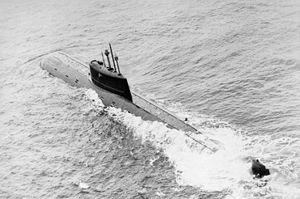 K-278 Komsomolets profile
| |
 K-278 upon deployment on 1 January in 1986.
| |
| History | |
|---|---|
| Name |
|
| Builder | Sevmash |
| Yard number | 510 |
| Laid down | 22 April 1978 |
| Launched | 9 May 1983 (3 June 1983) |
| Commissioned | 28 December 1983 |
| Decommissioned | 6 June 1990 |
| Homeport | Bolshaya Lopatka at Zapadnaya Litsa |
| Fate | Sank due to fire on 7 April 1989, killing 42 |
| Notes | Located in the Barents Sea in 1,700 m (5,600 ft) of water |
| General characteristics | |
| Class and type | NATO reporting name "Mike"-class submarine |
| Displacement | 4,400–5,750 tons surfaced, 6,400–8,000 tons submerged |
| Length | 117.5 m (385 ft) |
| Beam | 10.7 m (35 ft) |
| Draft | 8 to 9 m (26 to 30 ft) |
| Propulsion | One 190 MW OK-650 b-3 PWR (HEU <= 45%[1]), two 45000 shp steam turbines, one shaft |
| Speed | 14 knots (26 km/h; 16 mph) surfaced, 26 to 30 knots (48 to 56 km/h; 30 to 35 mph) submerged |
| Test depth | 1,000 m safe, 1,250 m design, 1,500 m crush |
| Complement | 64 (30 officers, 22 warrant officers, 12 petty officers and enlisted) |
| Armament |
|
The K-278 Komsomolets was the Project-685 Plavnik (Russian: проект-685 плавник, meaning "fin", also known by her NATO reporting name of "Mike"-class), nuclear-powered attack submarine of the Soviet Navy; the only submarine of her design class.
In the inventory of the Soviet military, K-278 was unique for her submarine depth rating, having reached a depth of 1,020 metres (3,350 feet) in the Norwegian Sea on 4 August 1984.[2] Although K-278 was commissioned in the Soviet Navy to evaluate the technology for the fourth-generation of Russian nuclear submarines, she was capable of combat maneuvering and deployment. During her third operational patrol in the Arctic Ocean in 1989, a serious fire in the aft compartments led to her sinking in the Barents Sea off the coast of Norway.[3]
Despite the fire in the engineering compartment, K-278 was able to surface and remained afloat for approximately five hours before sinking.[4] Many of the crew perished before rescue, leading to 42 total dead (and 27 survivors).
The wrecked submarine is on the floor of the Barents Sea, about 1.7 km (1 mile) deep, with her nuclear reactor and two nuclear warhead-armed torpedoes still on board.
- ^ "Marine Nuclear Power:1939 – 2018" (PDF). July 2018. Retrieved 30 December 2022.
- ^ "Хождение за три глубины". Военно-промышленный курьер. Archived from the original on 30 April 2021. Retrieved 9 May 2013.
- ^ "Ход развития аварии и борьбы за живучесть ПЛА "КОМСОМОЛЕЦ"". 26 July 2006.
- ^ Pope, Brian (May 1989). "Soviet Nuclear-Powered Attack Submarine Sinks Off Norway". Arms Control Today. 19 (4): 24. JSTOR 23624029.